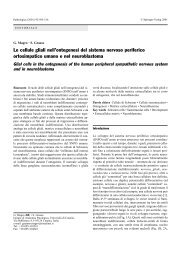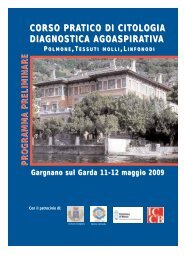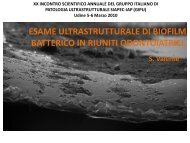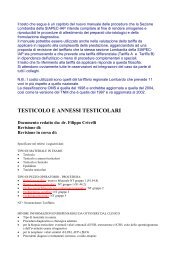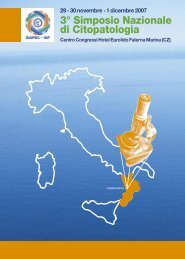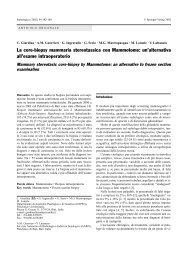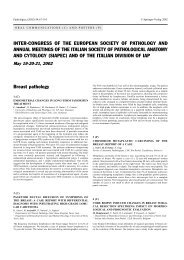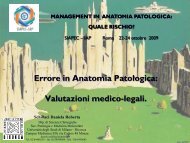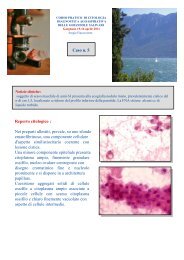Create successful ePaper yourself
Turn your PDF publications into a flip-book with our unique Google optimized e-Paper software.
320COMUNICAZIONI LIBEREpathologic (gross) dissection. Some studies demonstrate thatinadequate LMP dissection and assessment may be associatedwith unfavourable outcome of CRC.MethodsIn a prospective study, 172 consecutive patients (pTNM-Stage 0 = 25, Stage IA = 120; Stage IIA = 24; Stage IIA = 3)were considered. In previously assessed N0-LMP, ITCs wereassessed by immunohistochemistry (Cytokeratin pool, cloneMNF116; Dako; dilution 1:100) in LMPs serial sections.LMPs location was distinguished in LMPs located within 3cm and over 3cm from the CRC.ResultsOverall, 2567 LMPs were examined (mean x case 15; range1-107 (diameter cm 0.1-1.8). The results of the study aresummarized in the table.ConclusionsIn pN0, the prevalence of ITC accounted for the 31% of theconsidered LMPs. Such a prevalence could give raison of thedivergent clinical outcome of N0-CRC, as assessed by routinehistology. In CRC the prognostic relevance of ITCs aswell as its importance in the choice of the post surgical therapeuticoptions remains to be evaluated.Stage (# cases) ITC in ITC in TotalLMPcm 3 (%) number (%)Stage 0 (25) 1 (4) 0 1 (4)Stage I (120 ) 36 (30) 11 (9) 40 (33)Stage IIA (24 ) 11 (46) 1 (4) 11 (46)Stage IIB (3 ) 2 (67) 1 (33) 2 (67)Total 50 (29) 13 (8) 54 (31)Angiogenesis and oncogenes in colon cancerG. Perrone * , A. Verzì * , B. Vincenzi ** , D. Santini ** , G.Tonini ** , A. Vetrani *** , C. Rabitti **Surgical Pathology, Campus Bio-Medico University ofRome; ** Medical Oncology Unit, Campus Bio-Medico Universityof Rome; *** Department of Anatomic Pathology andCytopathology, University of Naples “Federico II”IntroductionThis study was designed to elucidate the possible relationshipbetween tumour related genes and angiogenesis in humancolon cancer. Recently, experimental results have shown thatsome tumour suppressor genes are involved in the regulationof angiogenesis 1 , and interesting data have been reported onthe genetic inactivation of p53 in cancer cells: loss of wild typep53 function contributes to activation of the angiogenic switchin tumours. Moreover, recent in vitro studies have demonstratedthat bcl-2 overexpression induces an increased secretion ofVEGF protein, the well-characterised angiogenic factor 2 .MethodsTissue samples of 57 archival paraffin-embedded surgicalspecimens of colon cancer were analyzed by immunohistochemistry,using streptoavidin-biotin method, for VEGF(clone A-20: Santa Cruz Biotechnology), Von WillebrandFactor (polyclonal rabbit anti-human: Dakocytomation), p53(clone DO7: Dakocytomation), and bcl-2 (Clone 124: Dakocytomation).3-3’-diaminobenzidine (DAB) was used forcolor development and hematoxylin was used for counterstaining.Negative control slides processed without primaryantibody were included for each staining. For the evaluationof VEGF expression, staining for VEGF was assessed usinga semiquantitative scoring of 0 to 3+. We graded p53 and bcl-2 expression on scale of 0 to 3+ according percentage of positivecells. Microvessel density (MVD) was assessed basingon Weidner criteria.ResultsThe results showed that MVD was lower in VEGF negativethan in VEGF positive tumours (P





